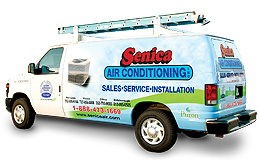Was your home built within the last 10 to 15 years? If so, the air quality in your home may be worse than you would expect. Modern homes have been specifically designed to reduce the amount of air that can escape from the building, causing an increase in indoor pollutants.
Because they’re so airtight for efficiency’s sake, newer homes don’t allow for proper natural ventilation. The reduced airflow does bring lower heating costs, but it also produces an increase in the moisture and humidity, which becomes trapped in your home. This moisture can produce unwanted mold, along other air quality concerns.
Fortunately, there are ways to improve air quality in your newer Florida home. Two machines, the heat recovery ventilator (HRV) and the energy recovery ventilator (ERV), have been developed to help solve ventilation problems.
Heat Recovery Ventilators (HRVs)
Although Florida isn’t known for blistering cold winters, many families do turn on the heat a couple months each year. It can be hard for you to see your heating bill jump during these months. Having a heat recovery ventilator can help keep your home warm while keeping costs down. On the flip side, during the hot summer months, the air inside your home stays cooler than the air outside, as the HRV also cools down incoming air.
An HRV is a type of ventilation system that uses the outgoing warm air to heat the incoming fresh air. Just like other ventilation systems, a heat recovery ventilator is made up of two fans. The first fan removes the air from inside the home, while the second brings in fresh air from outside. They work together to ventilate your home and improve air quality.
What makes the HRV different from other systems is the heat-exchange core, which works by having separate fresh air and house air passages. This system ensures that the outgoing air doesn’t affect the fresh air. The passages heat up as they move through the heat-exchange core. When the air flows through the heating core, it maintains about 85 percent of its heat. HRV systems also work to reduce the amount of air pollutants that enter your home. It’s very effective at keeping the air quality in your home high.
Energy Recovery Ventilators (ERVs)
An energy recovery ventilator (ERV) is another type of ventilation system. It’s similar to the HRV system in that it transfers heat, but it also regulates the humidity levels of the incoming air. It’s a great choice for Florida homes because it reduces humidity and cools the air during the warm summer months. It also works to humidify and heat incoming air during the cooler months. HRVs work to transfer sensible heat, whereas ERVs transfer both sensible and latent heat.
You may be wondering why the transfer of latent heat is important. Latent heat is energy that’s produced when a substance changes states. A good example is a pot of boiling water. When the liquid turns to steam, it produces latent heat. This also allows the air to be humidified or dehumidified during the transfer. Most energy spent in the home is during the act of humidifying the air. The result of reducing the cost of moisture control is a high increase in savings on your electricity bill.
Why Purchase a Ventilator?
HRV and ERV systems are perfect for Florida weather. They both allow fresh air into your home, helping to reduce utility costs and improve indoor air quality. An ERV system also humidifies or reduces humidity coming into the home.
For more information about whether an HRV or ERV is right for your home, contact Senica Air Conditioning, Inc., Inc. We proudly serve the HVAC needs of homeowners in and around the Tampa area.



